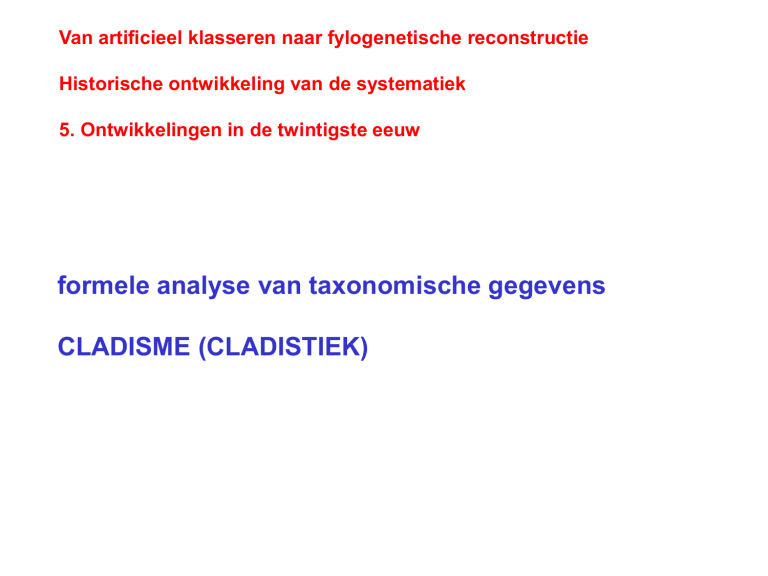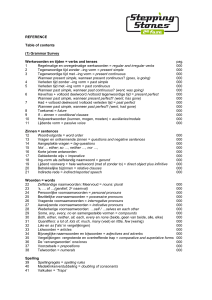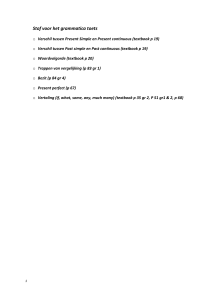
Van artificieel klasseren naar fylogenetische reconstructie
Historische ontwikkeling van de systematiek
5. Ontwikkelingen in de twintigste eeuw
formele analyse van taxonomische gegevens
CLADISME (CLADISTIEK)
Probleem
evolutie = afgelopen historisch proces
fylogenetisch onderzoek = historisch onderzoek
testbaarheid hypothesen (sensu Popper)
fylogenie = metafysica
If organisms have reached their present state by a process of evolution,
it follows that they have a built-in classification,
and that man’s problem is to find it.
This is quite a different problem from that presented to the classifier of
man-made objects ...
R. Holttum (1967)
Willi Hennig
1950
Grundzüge einer Theorie
der
phylogenetischen
Systematik
basishypothese van de
formele fylogenetische systematiek
convergente (“parallelle”) kenmerken
primitieve (plesiomorfe) toestanden
afgeleide (apomorfe) toestanden
gemeenschappelijk bezit van afgeleide toestanden
(synapomorfie)
= enige bewijs van afstammingsverwantschap
Hennig, Grundzüge einer Theorie der phylogenetischen Systematik
grondbeginselen
1. ‘verwantschappen’ tussen levende en uitgestorven organismen zijn genealogisch
2. Fenotypische en genetische gelijkenissen zijn het resultaat van afstamming
met modificatie (= evolutie)
3. Genealogische verwantschappen zijn te achterhalen via welbepaalde
kenmerken die ze aantonen
4. Beste classificatie ≡ fylogenetische (genealogische) classificatie
Cladistiek =
studie van de transformatie van kenmerken
voor het afleiden van
en toetsen van fylogenetische hypothesen
Apomorfie 1
Hennigiaanse argumentatie
A
a
b
c
B
C
Plesiomorfie 0
A
B
C
d
A
consensus
cladogram
B
C
taxa A en B zijn zustergroepen
taxon A
taxon B
C is de buitengroep
(‘outgroup) van A & B
taxon C
gemeenschappelijke
voorouder
(‘common ancestor’)
van A en B
CLADOGRAM
Cladisme ~ clade (monofyletische groep)
Werkwijze van de cladistiek
1. keuze studiegroep en EU’s (evolutionary units)
criterium: beide monofyletisch!!
2. keuze kenmerken en toestanden
3. polariteitsbepaling
4. matrix met plesio- en apomorfieën
5. spaarzaamheidsanalyse
Hennig 86, PAUP, PHYLIP
6. Vergelijking van de hypothesen (cladogrammen)
Werkwijze van de cladistiek
Polariteitsbepaling?
buitengroepvergelijking
Fossiele reeksen
Embryologische ontwikkeling
‘common equals primitive’
‘common equals primitive’
Apocarp = plesiomorfie van de angiospermen
Apocarp = plesiomorfie van de Ranunculaceae
Syncarp = plesiomorfie van de Solanaceae
apomorfie
Spaarzaamheidscriterium? (“parsimony”)
A
B
C
a
b
c
A
plesiomorfie
B
C
d
kenmerk d = “homoplasie”
Getransformeerde cladistiek
(Patterson, jaren 1980)
NUMERIEKE TAXONOMIE
CLADISTIEK
OTU: operational taxonomic unit
EU: evolutionary unit
principieel fenetisch standpunt*:
onderzoekt de fenetische verhoudingen
tussen OTU’s
principieel fylogenetisch *:
onderzoekt de cladistische
verhoudingen tussen EU’s
* evolutie bestuderen zonder fossielen = metafysica
(maar een goede fenetische classificatie
weerspiegelt de evolutie)
* de loop van de evolutie kan afgeleid worden uit
kenmerken van hedendaagse organismen
NUMERIEKE TAXONOMIE
CLADISTIEK
OTU: operational taxonomic unit
EU: evolutionary unit
principieel fenetisch standpunt*:
onderzoekt de fenetische verhoudingen tussen
OTU’s
principieel fylogenetisch *:
onderzoekt de cladistische verhoudingen tussen
EU’s
convergente kenmerken
plesiomorfieën & apomorfieën
incl. autapomorfie (beïnvloedt
fenetische afstand)
convergente kenmerken
enkel apomorfieën
autapomorfieën zijn niet informatief
multivariate analyse
bij voorkeur > 100 kenmerken
algemene statistische programma’s
rekentijd kort
bijzondere algoritmen
enkele kenmerken volstaan reeds
speciale programmatuur
lange rekentijden
fenogram (een dendrogram)
in principe één hypothese
cladogrammen
meestal meer hypothesen
synthetische classificatie, geen
uitspraak over
poly-, para- of monofyletische natuur
van erkende groepen
fylogenetische classificatie, enkel
claden (monofyletische groepen)
gevaar voor inflatie van aantal groepen
(American Journal of Botany. 1999;86:225-248.)
© 1999 Botanical Society of America, Inc.
What does morphology tell us about orchid relationships?
— a cladistic analysis
John V. Freudenstein and Finn N. Rasmussen
A cladistic analysis of Orchidaceae was undertaken for 98 genera using 71
morphological apomorphies based on a reconsideration of previous character
analyses and newly discovered variation.
All multistate characters were coded as unordered unless specified
otherwise.
Character analysis
0. root tubers 0 = absent, 1 = present
Root tubers are thickened roots that serve as organs of perennation,
producing shoots in subsequent seasons. These structures occur
primarily in the Diseae, Orchideae, and Diurideae and have been studied
intensively (e.g., Irmisch, 1850 ; Germain de St.-Piérre, 1855 ;
Prillieux, 1865 ; White, 1907 ; Ogura, 1953 ; Pridgeon and Chase,
1995 ). Triphora was scored as having a true root tuber, but Pogonia
and Isotria were not, even though their unthickened roots are known to
produce shoots (Ames, 1922 ). Nodular root thickenings are known
from Apostasia (Stern and Warcup, 1994 ), Tropidia (Dressler, 1981 ),
and possibly others, but these evidently do not produce new shoots.
1.root epidermis 0 = rhizodermis, 1 = velamen
2.exodermis 0 = unthickened, 1 = uniformly thickened, 2 = outer walls
thickened
3.exodermal cell shape 0 = ± isodiametric, 1 = elongate
48. seed laterally compressed walls 0 = absent, 1 =present
49. seed testa cell shape 0 = all isodiametric, 1 = end
isodiametric, middle elongate, 2 = all elongate
50. seed striations 0 = absent, 1 = transverse/reticulate, 2 =
longitudinal
51. seed intercellular spaces 0 = absent, 1 = present
52. seed wax caps 0 = absent, 1 = present
53. seed covered cell border 0 = absent, 1 = present
53 ↔ 71 ????
The equally weighted analysis found 60 000 most parsimonious
trees with low consistency (CI = 0.29) but high retention (RI =
0.83).
The strict consensus reveals a significant amount of structure,
and most traditionally recognized subfamilies are supported as
monophyletic, including the Apostasioideae, Cypripedioideae,
Spiranthoideae, and Epidendroideae.
Orchidoideae in the broad sense are paraphyletic, giving rise to
spiranthoids.
Vanilloids are sister to epidendroids, although exhibiting several
states otherwise found only in clearly basal groups, such as
Apostasioideae. The nonvandoid epidendroids are poorly
resolved, due to a high degree of homoplasy. The vandoids
appear to be monophyletic, contrary to recent molecular
evidence, possibly due to repeated parallel development of the
vandoid character suite.
Fig. 1. Consensus of 60 000 most parsimonious
trees from NONA analysis of equally weighted
characters.
Tick marks with numbers refer to clades
discussed in the text.
Decimal numbers are jackknife values (>0.50)
for clades from 10 000 replications.
Fig. 2. A single most
parsimonious tree from the NONA
analysis of equally weighted
characters.
Black boxes are unique
synapomorphies, and open boxes
are homoplastic characters.
Figs. 4–7. Mapping of stamen
characters on trees
from the present study and
from Neyland and Urbatsch
(1996a)
4. The most parsimonious optimization of the three stamen characters on the consensus tree from the present
study.
5. An alternate, less parsimonious optimization on the consensus tree.
6–7. Two equally parsimonious optimizations of the three stamen characters on the tree of Neyland and Urbatsch
(1996a : Fig. 2). Filled boxes are uniquely changing apomorphies, and open boxes are homoplastic characters.
The number of the character is indicated above the box, and the number following the ">" under a box indicates
the state to which that character changes.












